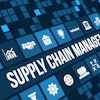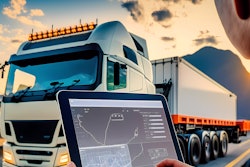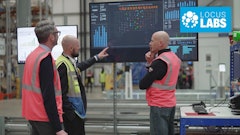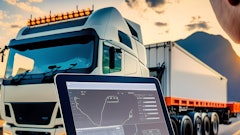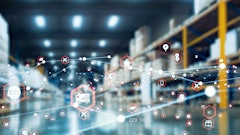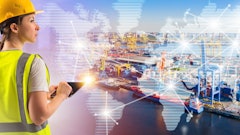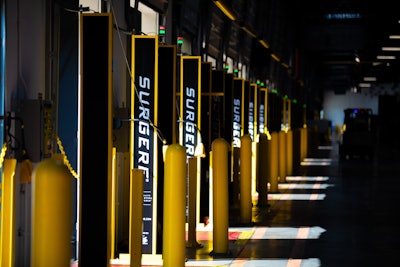
Food and beverage supply chain management is a story of constant adjustment and evolution in an ever-changing environment. Fluctuating consumer demand. The specter of perishability. Vital – yet often variable – safety regulations. Resiliency and reliability have never mattered more.
The good news is that artificial intelligence tools are helping companies deliver them while reducing logistics expenses. And now, agentic AI is driving the next transformation in food and beverage supply chain operations, moving beyond traditional automation and enabling self-learning systems that reduce cost, enhance traceability, and increase efficiency.
The AI impact and agentic advancements
Early adopters of AI technology are already seeing significant returns on their investment, with some companies realizing a 15% reduction in logistics costs, along with improved inventory and service levels. Agentic AI makes possible even more new solutions in food and beverage supply chain applications, but what is it, exactly?
Agentic AI refers to artificial intelligence systems with a higher degree of autonomy than previous iterations. Generative AI – the suite of familiar tools used to create content such as computer code, text, and images – requires people to enter prompts and train the programming. In supply chain management, generative AI helps with automation, but still needs humans to enter commands to function.
By comparison, agentic (having agency) AI can generate a series of actions or decisions without human intervention, because it continuously learns from its previous experiences and can execute complex tasks with little or no human involvement. By using machine learning and natural language processing, agentic AI can set goals and make its own decisions based on available information.
As a continuously learning technology, agentic AI utilizes real-time data for decision making, enabling it to build on the benefits of generative AI and other traditional supply chain management tools. An agentic AI system can examine and analyze market trends, competitor data, and historical information in order to provide insights that assist in strengthening supply chains. With these capabilities, it becomes possible to more accurately forecast seasonal demand shifts and identify potentially disruptive factors. For example: How will a weather pattern affect crop yields across a given region? What geopolitical forces are reshaping trade and transportation routes? Where are commodities costs surging?
Using incredible amounts of data from supply chains worldwide, an agentic AI system can learn the difference between a regular peak in demand that happens every summer or a unique stockout that's the result of a rare confluence of unforeseen circumstances. This type of insight can help you prevent planning future inventory around outlying events that don't really signify demand trends.
Streamlining and resiliency
Managing other common supply chain challenges is also handled more effectively by agentic AI. A system may note, for instance, that a particular shipping partner is raising its prices more than others, indicating it's either time to renegotiate that rate or explore lower-priced alternatives. By quickly pinpointing areas of spiking costs, agentic AI makes it possible to develop solutions before the increases have an impact.
Agentic AI tools help streamline operations by automating workflows. They enable real-time shipment tracking, plan and optimize routes and loads, and can even assist in customer service without human oversight. More complex tasks can now be handled by human team members,
With AI, agentic workflows are automated, helping streamline operations. You can use them to track shipments in real-time, plan and optimize routes and loads, and even tackle customer service. Because agentic AI doesn’t require human oversight, people can spend their time working on more complex tasks and handling critical real-world interactions.
Additionally, agentic AI can help boost team members' productivity by assessing daily operations and improving workflows. From sourcing and procurement through processing, packaging and labeling, agentic AI can analyze touch points and consider options for streamlining without impacting product quality.
Supply chain resilience depends on information, and an agentic AI system runs advanced analytics on tremendous volumes of data in order to provide it. Where traditional AI tools require supply chain managers to identify relevant data and enter it into the system before guiding analysis using a series of prompts, agentic AI runs analyses on its own, based on tasks it has already handled. This includes analysis that supply chain managers may not have considered. Ultimately, the process generates more accurate demand forecasts and earlier identification of potential supply chain disruptions.
Logistics is a prime area for realizing the benefits of agentic AI workflows, from optimizing routes for quicker, damage-free delivery to navigation that helps avoid political unrest, natural disasters, or other factors that can throw a wrench into supply chain operations. It's effective at the highest levels of tracking inventory from beginning to end and where the rubber literally meets the road in planning delivery truck paths through big-city traffic. And at every step, it keeps learning for the next challenge
Tools working together
By pairing AI with other evolving and innovation-driving technologies, we can make the tools even more effective.
IoT is a term for the “Internet of Things” and generally refers to technology powering devices that collect data. In the food and beverage supply chain, IoT technology generally refers to real-time tracking, monitoring, and automation to keep tabs on information like location, temperature, and condition of products to maintain freshness and quality. Examples include smart packaging that monitors environmental conditions during transportation and storage, and sensors that power smart warehouses.
Blockchain, for instance, means a secure database shared by multiple parties that allows for the exchange of encrypted data. For example, sharing a blockchain database with vendors permits everyone to input data as they initiate and complete transactions. As a result, everyone has real-time access to all transactions instead of having to update their own accounting systems and reconciling them with others.
When combined, agentic AI, IoT, and blockchain are a powerhouse for managing data and optimizing processes.
What's ahead
Agentic AI can provide more accurate predictive analyses than traditional systems because it works with so much more historical data. Given the precise conditions under which food and beverage products must often be handled along the supply chain, managing inventory levels is crucial. Agentic AI's predictive insights can sharpen companies' planning so they can better fill orders without carrying excesses and running the risk of generating food waste.
Predictive analytics also equip companies to better understand their customers' needs, delivering a competitive edge. Using agentic AI can help organizations shape plans to bolster their unique value proposition, improve their products, or strengthen their customer relationships. It's also a path toward identifying new business opportunities – particularly those which won't disrupt operations or carry too high a price.
When agentic AI is integrated as a supply chain management solution, it provides deeper and more effective analysis across the entire network, generating meaningful insights and driving more informed decision making. And when companies have the right tools to work and the right information is accessible, they get things done as only humans can: That's the real value of agentic AI.

